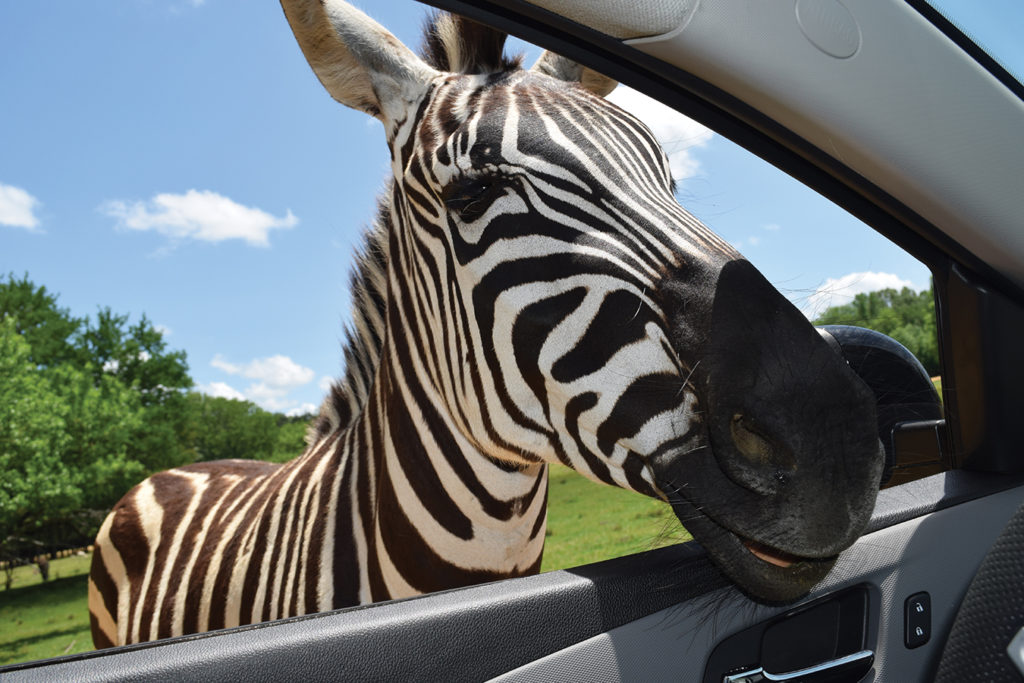Story and photos by Nick Thomas

Visitors to the Alabama Safari Park this summer can expect many of the animal residents to personally greet their human guests. In fact, you’ll have many eating out of the palm of your hand – literally.
Home to more than 800 animals, visitors to the 350-acre wildlife park just south of Montgomery in Hope Hull drive the facility’s 3-mile winding gravel road while pausing periodically to hand-feed the free-roaming zebras, llamas, ostriches, and many other species from food buckets through car windows.
“It’s very safe, but there are rules that should be followed,” says park founder and CEO Eric Mogensen. “For example, you must always remain in your vehicle. You can ride in the bed of a pickup truck, but you absolutely cannot exit your vehicle. We have staff constantly monitoring the park, ensuring everyone follows the rules.”
In addition to catering to the daily stream of curious tourists, the park is dedicated to wildlife conservation as part of the Zoofari Parks group, which operates similar facilities in other states.

“We work closely with other zoos and private breeders around the country on captive breeding programs to build a healthy population of animals,” Mogensen says. This includes their sister parks, Virginia Safari Park, Gulf Breeze Zoo in Florida, and their newest Texas Safari Park, which is opening soon. “Our collection (of animals) depends upon availability, and proper management depends upon facilities and staffing.”
The park also supports conservation projects both nationally and globally, as well as native Alabama wildlife programs, by offering grants ranging from $100 to $5,000. Supported projects include the Siaga Conservation Alliance, Pygmy Hippo Research, tortoise population research at the University of West Florida, the International Crane Foundation, and the Dian Fossey Gorilla Fund.
“We budget a certain percentage of our income to be used towards our conservation programs,” Mogensen says. “We believe that there are habitats and species around the world that need additional funding for their programs, and we are able to assist. Our guests can enjoy the fact that while they are enjoying our park, they are actually helping our conservation efforts.”
Mogensen says the park is entirely self-funding, accepting neither donations nor state or federal money. “Because we have been doing this for a long time, we have developed a successful business model that allows us to be self-sufficient. We operate on income generated by admissions, feed sales, our gift shop, and animal encounters.”

Feeding some new friends
In addition to the self-driving tour, animal encounters include hand-feeding giraffes with lettuce (available on-site). From the raised viewing platform, visitors can stand eye-to-eye with the tallest terrestrial animal in the world which, on average, towers some 16 feet over fellow inhabitants in their native African savannahs and woodlands.
For an additional cost, visitors can also feed vegetable sticks to the newest park residents – the slow-moving but gentle two-toed sloths. And in a separate exhibit, Madagascar’s most famous mammals – lemurs – are on display. The park’s ring-tailed and black-and-white ruffed lemurs represent two of the 100 lemur species that are only native to the west African island nation.
There’s also a petting area with goats, potbellied pigs, chickens, and baby llamas, and at the Kangaroo Walk-About area, the famous bouncing Aussie marsupials could be leaping effortlessly across the grassland, lazing in the Southern sun, or tending to baby joeys in their pouches. Barnaby and Armstid, a pair of Giant Anteaters, are also recent additions to the park’s menagerie.
While Alabama is home to several traditional zoos, Mogensen doesn’t view the park attraction as a commercial rival.
Different from a zoo
“Before we built this park we were in close contact with the management of the Montgomery Zoo and have been careful to be an asset rather than competition,” he says. “We offer a very different experience than the Montgomery or Birmingham Zoos because our park is a drive-thru safari park. Guests can interact more with the animals and have closer encounters with various animals. It’s worth noting that our organizations are very supportive of one another.”
The region just south of Montgomery was selected for the Alabama park site due to the abundant grazing fields. And with Interstate 65 just minutes away, there’s easy access for travelers passing through the area looking for an interesting detour.
For the animals’ safety, visitors cannot provide outside food of any kind, but buckets of suitable feed are available for $5 at the gift shop. But with a constant mobile human food delivery service throughout the day, could the animals overeat?
“Our animals tend to self-regulate when being fed,” Mogensen says. “That is why every trip through is a different experience. When an animal eats and gets full, it will tend to move off and settle down for a nice rest.”

In addition to daily park passes, annual memberships are also available offering unlimited visits.
“We are constantly adding new animals and exhibits and are always planning for the future,” says Mogensen. “A guest should always notice something new with each visit.”

The Alabama Safari Park is open daily (except Thanksgiving and Christmas days), with summer hours from 9 a.m. to 5 p.m.; last admission is 4 p.m. Adults are $22.95, with discounts for children, seniors, and the military. Admission grants access to the Safari Drive-Thru and Walk-Thru areas for the entire day (receipts allow re-entry to the park). Wagon rides are also available for $10 per person.
The park is located off I-65 at Exit 158 at 1664 Venable Road, Hope Hull. Phone 334-288-2105 or go to www.alabamasafaripark.com for more information.
Nick Thomas teaches at Auburn University at Montgomery (AUM) and has written features, columns, and interviews for numerous magazines and newspapers.




